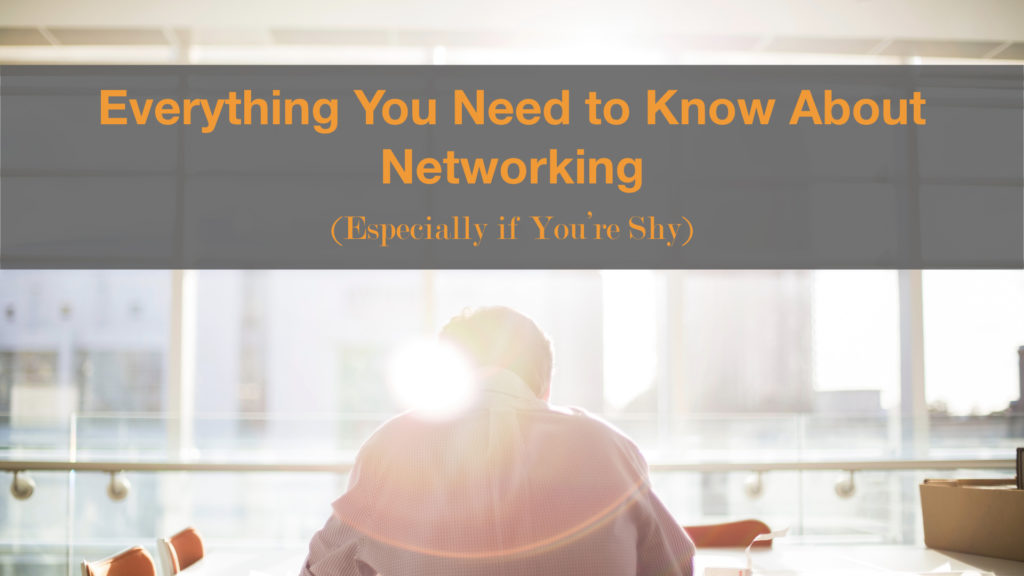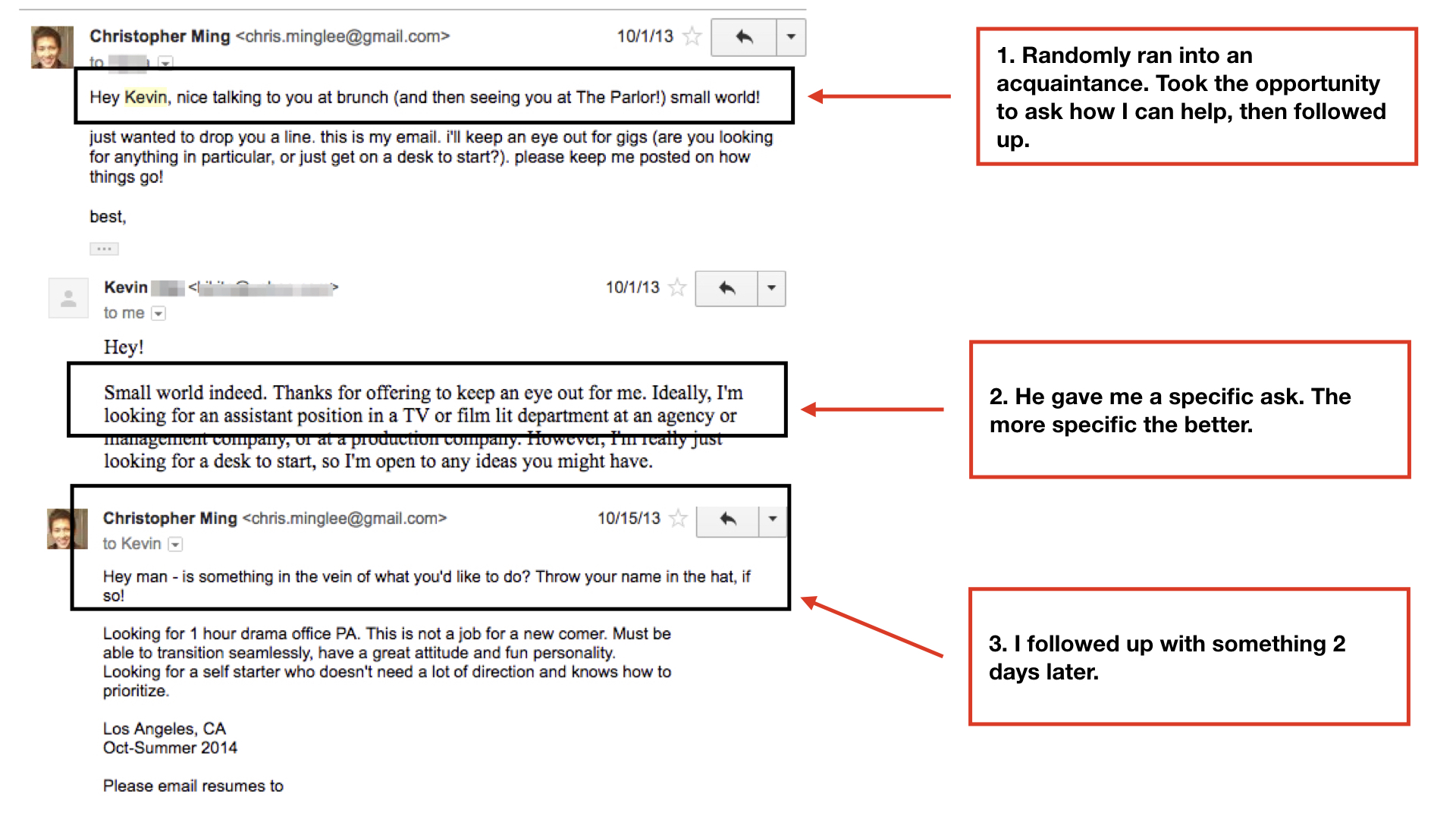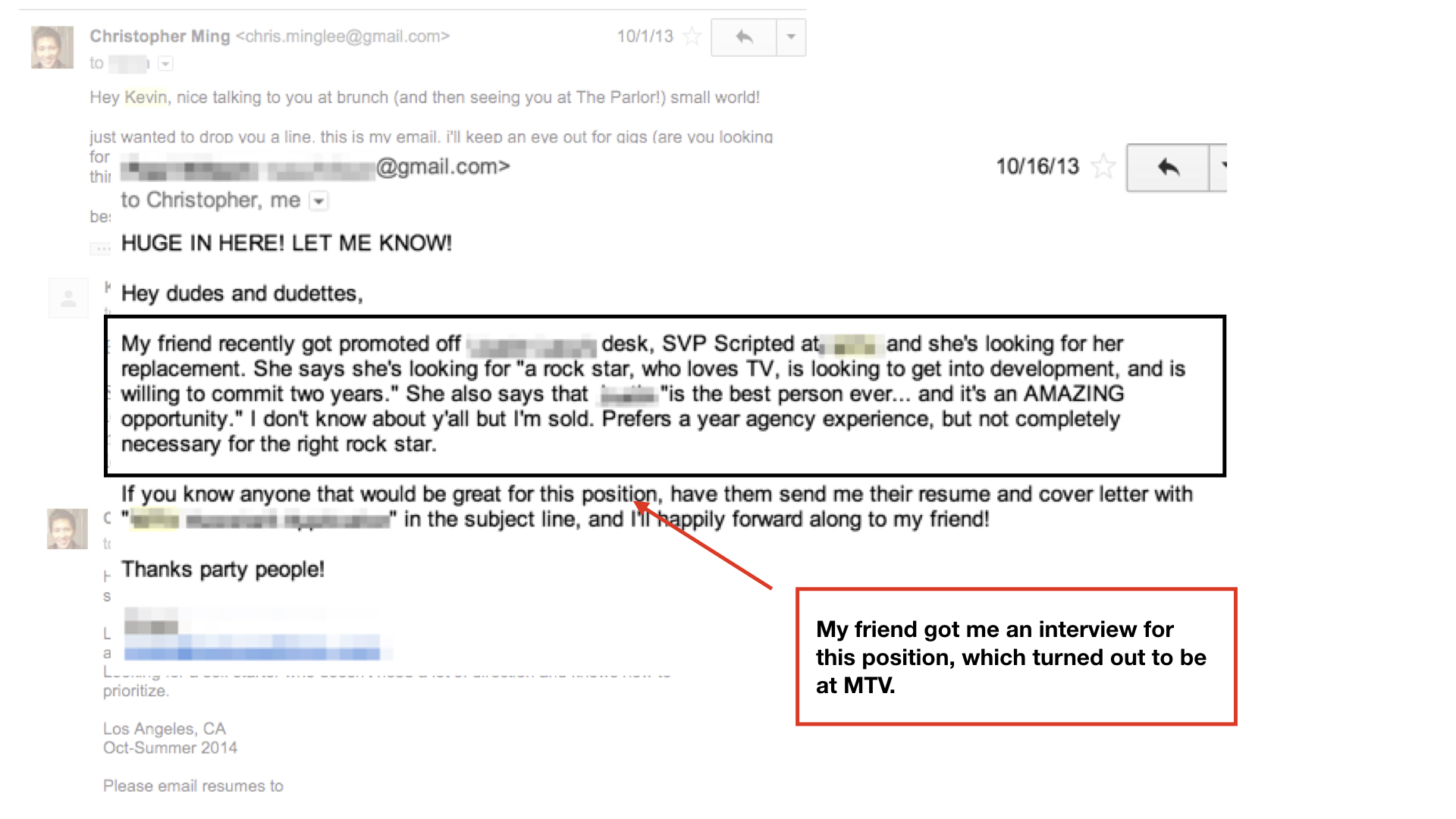Let’s not waste any time.
Improving your ability to network is not about becoming more charismatic. It’s not learning to smooze, and it’s really not about introverts vs. extroverts.
Sure, these play a role in creating relationships with other people, but we’re going to skip over most of it. It’s stuff you’ve already heard before.
Instead, here’s what we’ll cover:
- The 3 principles of authentic networking
- How to network if you’re an introvert
- Who buys the coffee? and other networking logistics
- How to stand out when meeting new people
- How to follow-up after any meeting
First, two quick stories about why I’m writing this:
First story: My crash course on Hollywood networking
Meredith opened her planner.
“I have a lunch, dinner, and drinks scheduled for each day that week.”
Her boss, she explained, lost his deal at the studio and finding him a new home was her top priority. That’s where Meredith’s social calendar came in.
Except… how was she supposed to make that many meetings? Meredith smiled.
“I don’t have to. At least half of these people will reschedule. That’s just the way it is. I just don’t know which half!”
Welcome to Hollywood. If there’s one place to make your bones when it comes to networking, it’s here. This is where I got my crash course. Networking (or “doing drinks” as it’s called) is as deeply ingrained into the Hollywood machine as Jack Warner and 35mm film.
Many of us make our start as the lowliest cog in the machine, a Hollywood assistant. We are the grunts, whose parents ask every Christmas why we bothered with a 4-year university if all we’re going to do is answer someone’s phone and fetch coffee. Building a network isn’t an extracurricular, it’s a means of survival. Your network is the only way you’re getting off that assistant’s desk, and that makes Hollywood assistants the best in the game.
This is the environment where I developed my approach to networking.
Second story: “It’d be weird to reach out”
This year I’ve met a lot of product managers and marketers in New York City. I always ask: “Do you find it hard to meet other tech people in the city?”
Inevitably, I hear:
- They wish there were more opportunities to network, like their SF counterparts
- They hate networking
Conundrum.
For example, one head of Growth at a fintech company was complaining about all the salespeople he ran into at an event.
“How’d you know they were salespeople?” I asked.
“They talked to me for 15 minutes, made sure to make me laugh, then got my contact information before moving onto the next person.”
Others were less cynical, but they still struggled. They said building their network in tech was one of their top priorities. They went to a bunch of events in the past, and said they met some good people. I asked if they kept in touch.
“No… I didn’t get their email. And it’d be too weird to try and reach out now…”
Stories like that prompted me to write this post and share what I’ve learned about networking.
If you’re looking to build your network of professionals where you can exchange ideas and build long-term relationships, but you’re not sure how to start, this post is for you.
The 3 principles of authentic networking
First the touchy-feely stuff. These are admittedly fluffy.
But they’re the table stakes of authentic networking. Without this foundation, none of the strategies matter:
1. Start with good intent
Your heart has to be in the right place. Be in this to help others. Make every interaction you have with another person, however brief, a positive one. Their day should be brighter because you were a part of it. Some days, you do this by helping them land a job. Other days, it’s because you gave them their first smile all week.
Good intent first. Then build relationships for life.
Conversely, without good intent, the best strategies are sleazy.
Also: good intent is practical too. Good intent means you can move fast. If your heart is in the right place, you waste zero time second guessing how others interpret your behavior. You stop caring what anyone else thinks, and plunge forward into the future with optimistic abandon.
2. Take nothing personally
You can tell when someone’s new to Los Angeles: They still get mad when people flake.
It can be infuriating, I get it. People cancel. Or they ghost you. It happens. Once I started giving everyone the benefit of the doubt, life just got easier.
Last minute cancellation? Enjoy your free night. Constant rescheduling? If it’s important, keep trying. If it’s not, let it go. When you take nothing personally, you’re playing the game the way it’s meant to be played, like a marathon. You can be patient, because opportunities circle back.
Related: This also means don’t hold grudges. Grudges are a timesuck, second only to caring about what others people think (see above). There’s no time. I’m not saying completely forget if someone screws you — that’s important data — but don’t take it personally.
3. Networking is a tool
If the idea of you networking feels sleazy, the problem isn’t with networking. The problem is with you.
Networking is a tool. You use it to create new opportunities for others and yourself. It’s just like a screwdriver or a hammer. Do you blame the hammer if you stick the nail in the wrong place?
You can use the advice and be sleazy. You can badger people and act annoying. Or you can give people value. It’s up to you.
How to network if you’re an introvert
You get over it.
If you’re shy or an introvert, you can’t just learn the latest LinkedIn networking techniques, connect with people online, and call it a day. It doesn’t work.
All our feelz about being an introvert or extrovert are irrelevant. Networking is how we create relationships that lead to new opportunities. There’s no room for feelings about being too shy to network. No time to get upset about missing out on the job or promotion because it’s “all about who you know”.
Yes, it is. This is about market dynamics.
It’s the same market that allowed Craigslist to kill the classifieds, Refinery29 to gobble market share from Conde Nast, and Amazon to swallow Whole Foods. You’re not crying over any of them, are you?
What can we do about it? If you’re happy with the opportunities coming to you, then you don’t have to do anything. If you’re happy, you’re good. You won, great job.
But if you’re not satisfied, and you’re looking for more opportunities but haven’t started building your network, then this is for you. Fortunately, the first step to get better at networking is simple. You don’t need to go to some social skills boot camp, join an exclusive social club or go to a dozen MeetUps.
For most people, the best first step is:
Prepare better than anyone else
Spend a disproportionate amount of time researching and preparing for every person that you meet.
When meeting other Hollywood assistants, there’s a game of one-upmanship. What deals do you know about? Who’s attached to what project? How’d it happen? Typically, the faster you can “connect the dots” — understand and explain the relationships that greenlit a project — the better you are.
Unfortunately, I wasn’t very good. I trudged from A to B, then took 2x as long to mosey my way to C. I simply didn’t have the institutional knowledge. So I did the next best thing:
I cheated.
By the time we met over drinks, I knew everything about that assistant. More than the usual suspects (role, company, college).
If they worked for a literary agent or a manager, I knew every active deal they got mentioned in the trades. If they worked with talent, I knew who just got signed, and who got fired. If they worked at a production company or studio, I knew every project that was getting ink, and who the principals were (actors, directors, writers).
Knowing what the other person was working on inside-out made carrying my side of the conversation much easier.
How do you prepare better than anyone else? You do your homework. Here’s what that looked like for me. Depending on how much you find on the Internet, going through this list takes 30 to 60 minutes:
- Google them. Simple enough
- Read their blog if they have one. Start with 5 of their most recent posts AND 2-3 of their FIRST posts. Learn the trajectory of their writing
- Read anything they published. Guest posts, company blogs, something at university
- Hit up the social channels. Start with the Big 4: LinkedIn, Facebook, Twitter, Instagram. Go through all of them. They each present a different portrait of the same person. LinkedIn is for future employers, Facebook for their parents, Instagram for their friends, and Twitter for the rest of the Internet. Put it all together, and like an FBI profiler, you got a good composite of the person
- Take notes. I use Google Docs, but you can use Notepad or Evernote or whatever — as long as it’s accessible from your phone. Review your notes before the meeting
Who buys the coffee? and other networking logistics
I remember this scene from Titanic: Jack is out to dinner with Rose and her bougie fiance and friends. He looks down at his plate, and is horrified to find he must choose between like, 17 different kinds of forks.
“Which one do I use?”, he whispers to Molly Brown.
“Start with the outside. Work your way in”, she says.
A lot has been written about how to email someone to ask them out to coffee or for advice. But until confronted with 17 forks, we don’t give much thought to the logistics of an event.
- What happens when someone agrees to meet?
- Where should you sit?
- Who buys the coffee?
- What if it’s drinks?
- How do you pick a good location?
These are my notes on networking logistics that continue to work for me:
Respect the status
When 2 people meet, there’s always a higher-status and lower-status person (typically, the lower-status person asks for the meet). If that’s you, pick a location that’s convenient for the other person.
On the flip-side, when you’re the higher-status person, don’t be shy about suggesting locations convenient for you. It’s about practicality, not ego — the easier it is for you to meet people, the more you’ll meet.
Noise kills the connection
The worst thing is having to constantly repeat yourself when getting to know someone. Noise-level is my second consideration when choosing a place to meet, after location.
Build your list of go-to’s
Keep track of all the places you go. I sort my list by area or neighborhood. For example, in Los Angeles: Weho, Beverly Hills, Culver City, Silverlake, etc.
In San Francisco: Hayes, Soma, Russian Hill, the Mission, you get the idea. The point is, if someone suggests a certain neighborhood, you don’t want to waste 30 minutes Yelping and emailing back and forth suggestions. Again, the easier it is to meet people, the more people you meet.
Building your list of go-to’s can take a few months, but it’s worth it in the long run. Here is my LA list of go-to’s.
Always drinks, never dinner
Few reasons for this: Getting a cocktail or a coffee is much faster than sitting through a meal. Avoids the “talking with a mouth full” problem. And personally, I like buying for the other person, and without an expense account, it’s easier on my wallet.
Order the usual
Networking drinks or coffee isn’t the place to try something different. Order decisively and stick to what you know.
What about breakfast or lunch?
Personally, I don’t do many breakfasts or lunches. They pull me away from my high impact work times. The break and re-ramp up isn’t worth it.
On the flip side, however, if you’re trying to meet as many people as possible, that’s 2 additional times you can slot someone in.
How to buy their coffee
My favorite tip from Ramit. The person who extends the invitation buys. Here’s how I do it: Show up early and sit close to the entrance, facing the door so they see you when they walk in.
When they arrive, say, “I’m going to grab a drink. Would you like something?” Leave a jacket or sweater to hold your seats. In line, make small talk.
You order first, and afterwards add, “…and whatever they’re having.” Pay for the drinks, and make your way back to your seats.
Avoid group drinks
With 1-2 extra people, group dynamics shift. Unless you’re fluent in getting a group to interact with one another (asking questions to the whole group, when to speak up and when to shut up) it’s hard to build rapport. I’d recommend avoiding these, especially in the beginning.
Keep “city” lists
This is one of my favorite tips: Keep lists of people who live in specific cities you plan on visiting. When you plan your trip, you already know who to reach out to.
It takes time to create the list, but once you have them, they’re incredibly handy. I like to set-up coffee or drinks a few weeks in advance, because scheduling can be tight. Try and get a soft hold on the date, then iron out the details closer to the day of.
Finally, how many coffees or drinks should you schedule each week? It depends on your goals and if you’re actively hunting for new opportunities. Meeting new people and creating “loose connections” — contacts of your contacts — is where you’ll find those opportunities. As a Hollywood assistant, when meeting new people was half the game, my baseline was scheduling 3 meetings a week (inevitably at least 1 would cancel).
These days I aim to meet at least one new person a week.
How to stand out when meeting new people
If you ask someone who works in entertainment, “How’s your day going?”, 99% of the time you’re going to hear the same response: “It’s crazy. Crazy busy.”
That’s literally everyone’s response, all the time, everyday. Then, because you asked, they’re compelled to explain why it’s so crazy. This happened a lot. Inevitably, it meant the rest of the conversation sucked.
Why did we go down that rabbit hole? Why did I feel compelled to ask the same question everyone asks, when I already knew the answer? Because that’s considered polite?
What if I stopped asking and took a different approach?
I started testing different openers to start conversation. After a lot of experimenting, I realized some openers naturally led to fun, engaging topics. I call these conversation ladders, because one fun topic literally laddered to the next.
The best thing about conversation ladders: You are responsible for guiding the conversation and determining where it goes. If you’re not having fun, feeling like you’re getting to know this person, it’s your responsibility. You set the conversation on its path.
When you take ownership of your interactions, you can also make them better the next time.
Here are the openers to my 3 favorite conversation ladders:
1. “What are your plans for this weekend?”
Or, if it’s Monday or Tuesday, “What did you do this weekend?”
Simple, casual, and 100x better than asking about work. The trick to this one: Be prepared to talk about your weekend as well. You have to share something fun you did, too.
Don’t say, “nothing exciting” or “sat around and watched Netflix all day.” Not allowed. Which means… do fun things on the weekends! Find things to do, and then be ready to talk about them.
(I get it: Sometimes watching Netflix all day IS what you did or what you want to do. Should you lie? Never. In that case, be specific and enthusiastic. I remember once saying, “Honestly, all week I’ve been looking forward to doing nothing but binge watching Justified, season 2.” The assistant across stopped drinking his beer. “Man, that sounds amazing.” If you’re doing “nothing”, it’s by choice.)
2. “Did you see on…”
When using this opener, a few things to keep in mind:
- I use it right after exchanging hello’s. It feels abrupt, and that’s the point
- You have to come in high energy for it to work
- Never use this to talk about anything work related
- 90% of the time my go-to is pop culture. The kind of stories you’d find on US Weekly or TMZ — those stories make it in there for a reason
But how do you know what pop culture topic to bring up? Should you talk about Kendall Jenner or about The Americans season finale? How amazing the reputation tour is, or the olive branch Katy sent to Taylor?
That’s where the research comes in. If you’re over-prepared, you’ll know where to start. Pick a topic you want to talk about AND they’ll have an opinion on. Yes, you’re gaming them. Yes, they probably know. But when done right, it doesn’t matter. They’re enjoying themselves too much.
3. “What would you do…”
This is my favorite. It’s evergreen, meaning you can use it anytime. It works for any topic (and is the one exception where I’ll talk about work). And it works well for groups.
Like the opener before it, this should come right after “hello” and be high energy. This is the formula:
Story + “What would you do?” + Story conclusion
Here are a few of my favorite ways to use it (stories abbreviated for clarity):
- “A client asked me to find the email of a woman he met at an event last night… and offered me $1,000 if I do it. What would you do?”
- “My boss asked me to Fedex his stool sample to his doctor today. What would you do?”
- “I think my buddy is making a mistake. He planned this extravagant evening for a woman he’s seeing, but she’s not into him. What would you do?”
Some openers will work better. Test them — certain stories require practice to nail the delivery. Once things start clicking, you’ll notice you stop dreading networking. Instead, it’s actually fun.
A couple of miscellaneous notes:
- Admit you looked them up. Privacy is dead. Instagram knows you had a Sprinkles cupcake for breakfast and Twitter knows you’re reading Ready Player One. No point in being coy. Usually, I’ll say, “I saw on your Instagram story you went to the playoffs this weekend. That’s so awesome, did you meet Lebron?”
- Stop with the phone. If you’re there, be there. Silence it and put it away. At the very least, place it face down on the table.
- Focus 100% of your energy on having fun and listening. Then, as the meeting is winding down, wrap up with: “It was great talking with you. I’m working on A, B, and C. It sounds like you’re working on X and Y. Is there anyway I can help?”.
How to follow-up after any meeting
Here’s one of my favorite ways to follow-up a meeting:
Yes, it’s good karma to help others out. It’s not all flower petals and kum-ba-yah, though. It’s also insanely practical. Do it 10 times, 20 times, and eventually opportunities will flow back to you.
Personally, I do it for selfish reasons, too. I want to be the one who creates opportunities for others. I want to be thought of as “that guy you go to for help.” That takes work. You build up to it. You consistently follow up with people and find ways to provide value. Here’s my approach:
- Take notes immediately after the meeting. Do it while the memory is fresh, while walking to the car or the train. Do it as soon as possible. Anything that comes to mind for at least 2 minutes — their dream role, where they’re from, what books they’re reading or want to read… anything I could add value to in the future. Then I save these notes to their contact information.
- Follow-up the next day.I’ll email them: “Great to meet you. Loved how you talked about X. Here’s that blog post/script/book I mentioned. Looking forward to reading/watching Y”, Y being something they recommended.
- Schedule one more follow-up.When I meet someone I really connect with, I don’t want leave the relationship to chance. I want to stack the deck. I’m looking for ways to connect again. So I’ll put in my calendar, 2-4 weeks later, a reminder to follow-up again. If I said I’d read something, I’ll read it and report back. I’ll try to stand in their shoes and think about what’s happening in their world… and how I can help or add value.
We’ve covered networking if you’re shy, the logistics, how to stand out, and how to follow-up.
This is basically everything I learned about networking over the last 5 years, condensed to a single article.
If you try any of the advice, please email me and let me know. I’d love to hear your experiences with it.
###
Photo Credit: Bethany Legg, Charisse Kenion, Chase Clark, Shttefan, Karl Chor, Victoriano Izquierdo








3 Comments
Pingback: 10 Remote Jobs With No Experience Required (and How to Land Them)
Pingback: The Best Places to Live in Los Angeles: 2022 Guide to LA
Pingback: - Remote Life OS